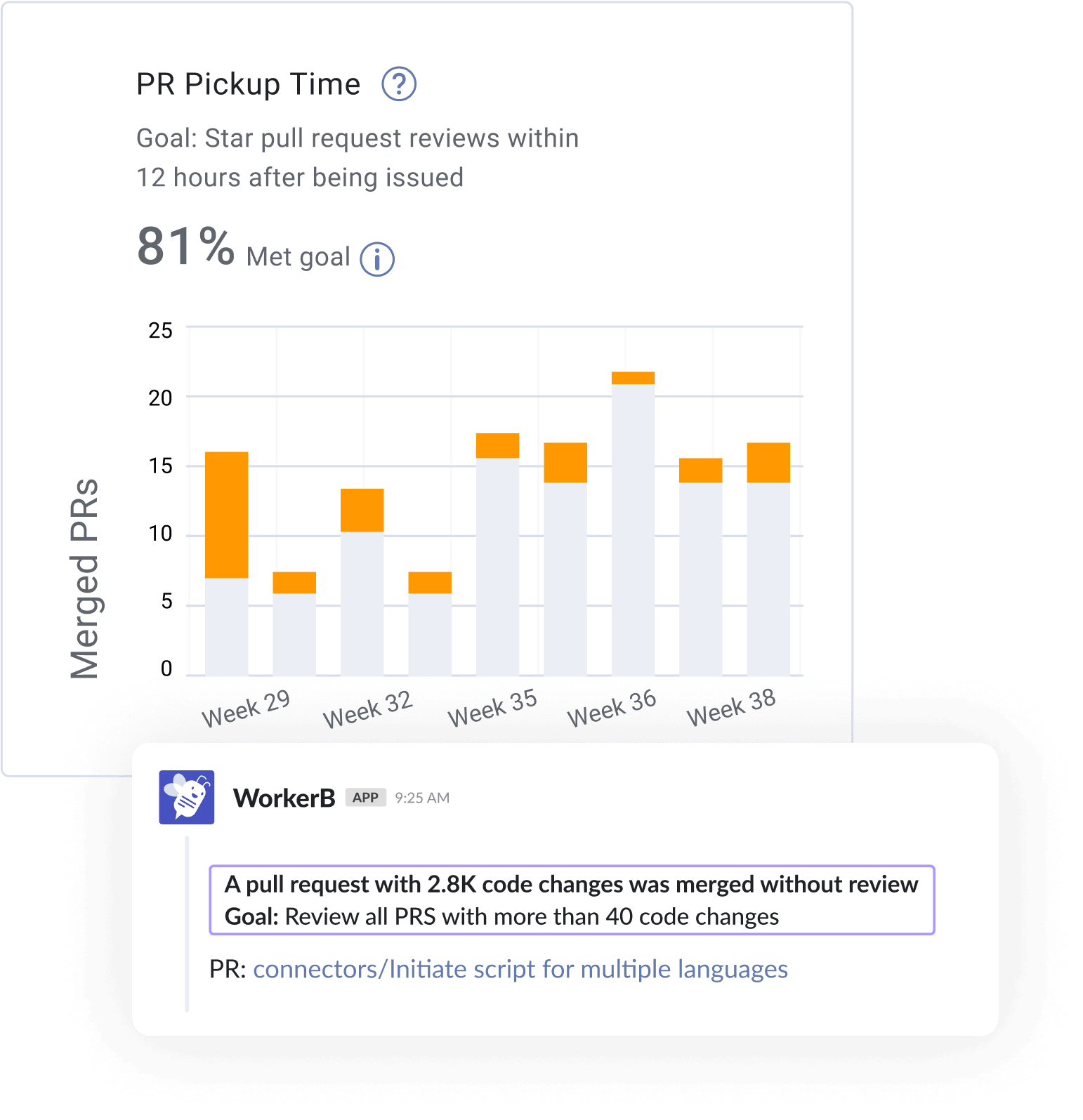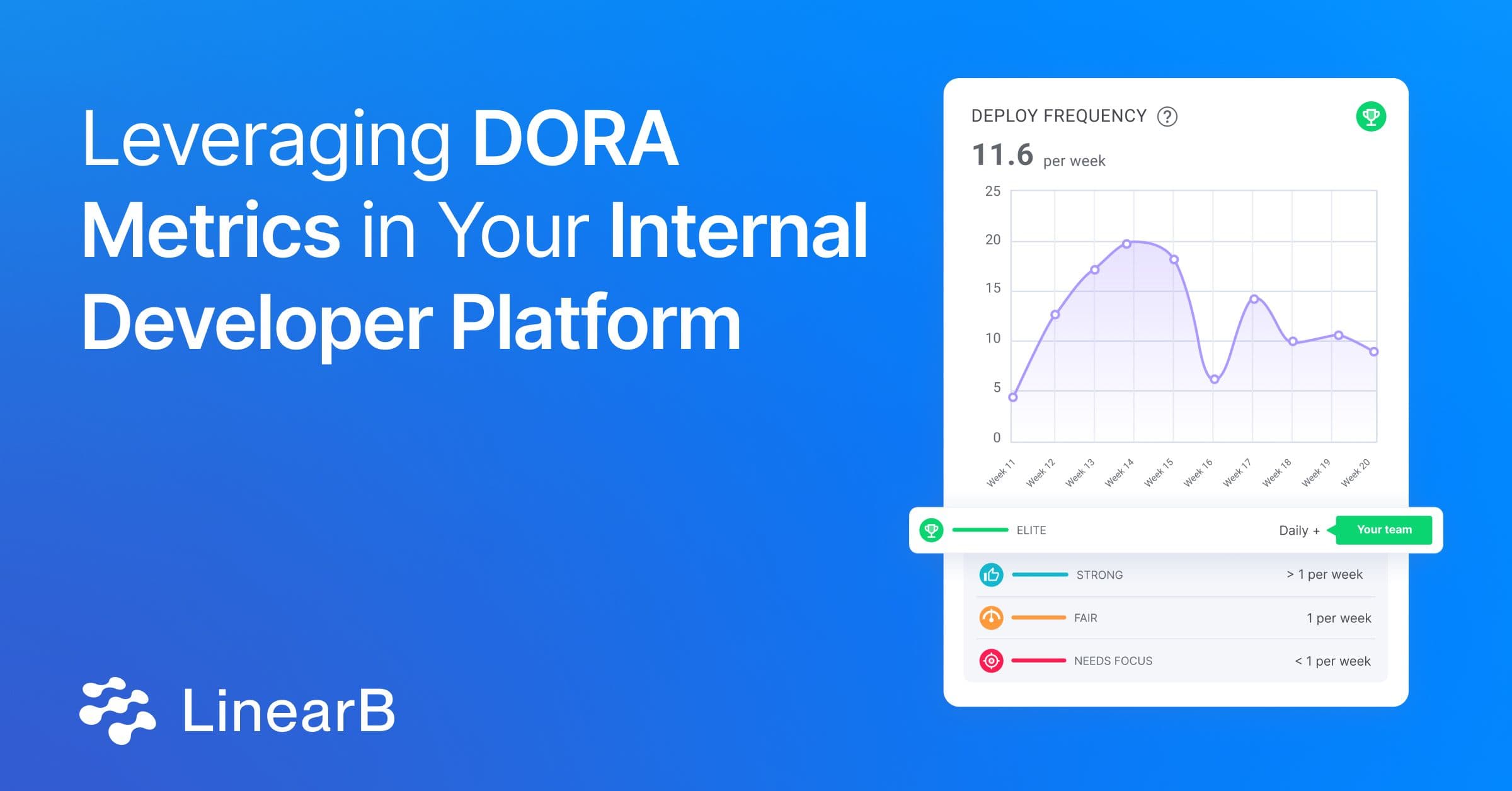DevOps Research and Assessment (DORA) metrics have become a cornerstone for high-performing engineering organizations. However, metrics alone aren’t enough; your organization must go beyond measuring by integrating DORA into your Internal Developer Platform (IDP) in a way that enables teams to take direct action based on the insights the IDP surfaces. This article will explain how combining DORA metrics with your IDP can improve your engineering operations and will provide practical guidance on how to implement DORA effectively.
The Benefits of Incorporating DORA Metrics Into Your IDP
Integrating DORA metrics directly into your Internal Developer Platform transforms abstract metrics into everyday decision-making tools for both engineers and leaders. This integration fosters greater visibility, accelerates continuous improvement, and strengthens engineering culture. Let’s explore the key benefits of bringing DORA metrics into your IDP. From real-time performance tracking to building a culture of accountability, you’ll see how this approach helps teams ship better software, faster.
Improve Team Visibility
DORA metrics provide a pulse check on software delivery performance in real time. By embedding them directly into your Internal Developer Platform, teams gain instant visibility without relying on disparate dashboards or tools. This unified view ensures everyone can monitor progress and quickly identify trends.
Foster a Culture of Continuous Improvement
Continuous improvement thrives on consistent feedback. With DORA metrics integrated into the IDP, teams can regularly review their performance, pinpoint bottlenecks, experiment with solutions, and measure the impact. Frequent access to DORA metrics means teams are better equipped to align their day-to-day activities with organizational goals for faster, more reliable software delivery.
Support Data-Driven Decision Making
DORA metrics democratize performance data. Engineering leaders can use aggregated insights to make informed decisions about tooling, training, or process changes. Developers can connect their contributions to broader team outcomes. For example, a spike in CFR could justify DevEx investments, ensuring you allocate resources where they’ll have the most significant impact.
Reinforce Engineering Culture
Embedding DORA metrics into your Internal Developer Platform fosters a culture of accountability, transparency, and collaboration. Teams are more likely to prioritize behaviors that improve these metrics, such as smaller, more frequent deploys and more comprehensive code reviews that reduce errors. This shared focus on measurable outcomes strengthens team alignment and reinforces a high-performing engineering culture.
How to Incorporate DORA Metrics into Your Internal Developer Platform
1. Adopt This Mindset: Get Better at Getting Better
When implementing DORA metrics, your ultimate goal should be to apply improvements that make your organization more efficient and effective. So, the first step when adopting DORA is to adopt a continuous improvement mindset that focuses team effort on solving collaboration challenges. Failing to adopt this mindset will set you up for failure
Do you suspect that external factors are disrupting development timelines? Are developers complaining about long CI wait times, lack of knowledge sharing, or difficulty merging code? Are you unable to articulate engineering resource needs to company leadership? Are you stuck trying to coach developers to advance their careers?
DORA metrics won’t solve any of these problems, but they will help you adopt a data-driven approach to analyzing your team and organization's challenges. DORA metrics are a great first step to getting visibility into Developer Experience (DevEx), but the real challenge is leveraging DevEx over the long term to improve productivity.
2. Connect Data Sources
To take action on DORA metrics, you will need to automate data collection from three sources:
- Code repositories (GitHub, GitLab, BitBucket) contain most of your developers’ activity metrics, including commit history, code review interactions, CI services, and AI agents.
- Your project management software (JIRA, Shortcut, Azure Boards) contains information that ties developer activity metrics to company projects, epics, and initiatives.
- Incident management platforms will contain information relevant to CFR and MTTR, particularly timestamps for when incidents start and end and a record of which service or repos were impacted by the incident are all important.
The simplest way to achieve this is to integrate your Internal Developer Platform with a Software Engineering Intelligence (SEI) platform like LinearB. SEI platforms automate data collection and analysis to guide you toward the improvements that will impact your organization most.
3. Standardize Team Practices for Success
DORA metrics are most impactful at the team level because they provide a frame of reference for data-driven conversations about team process bottlenecks and blockers. You want to make it easy for teams to quickly see where they should focus improvement efforts or articulate why and how they need support to other teams.
One of the most effective ways to improve DORA metrics is by standardizing team practices around the key behaviors that drive success. High-performing teams rely on repeatable, intentional processes that are easy to follow and enforce. By aligning teams around shared best practices, such as right-sized pull requests, timely code reviews, and consistent deployment patterns, engineering leaders can create a foundation for continuous improvement.

The best SEI platforms make this process easier by surfacing actionable insights and providing automated nudges to reinforce these behaviors in real-time. When you embed best practices into daily workflows, teams reduce variability, eliminate bottlenecks, and achieve more predictable delivery outcomes. Standardization doesn’t stifle creativity; it reduces operational noise and frees developers to focus on high-impact work.
4. Create Dashboards and Visualizations to Provide Context and Insight
Data without context leads to confusion, but data with context drives action. Effective dashboards should go beyond vanity metrics to offer a clear, real-time view of team performance across all DORA metrics. Enable teams to customize metrics dashboards to highlight trends, identify bottlenecks, and spotlight at-risk work to make it easier for teams to course-correct before problems escalate.

Visualizations should be simple, intuitive, and focused on what's actionable, not just what's measurable. When teams can see their progress and understand how their daily actions influence larger goals, they stay more engaged, accountable, and aligned with business outcomes.
When Should You Implement DORA Metrics in Your IDP?
Incorporating DORA metrics into your IDP is particularly impactful when your organization is already tracking DORA metrics but lacks centralized visibility. Without a unified view, it’s difficult for teams to see how their actions influence overall performance. DORA metrics bridge this gap by connecting day-to-day behaviors with delivery outcomes, helping teams understand the "why" behind their work.
This approach is especially valuable for organizations fostering a continuous delivery and operational excellence culture, as it reinforces a growth mindset and prioritizes improvement. Embedding DORA metrics into your Internal Developer Platform combines the power of a single source of truth with actionable insights. Benefits include:
- Enhanced developer productivity through streamlined workflows and automated feedback loops.
- Shortened cycle times by identifying bottlenecks early.
- Improved software delivery outcomes with a consistent focus on performance metrics.

DORA metrics provide a proven framework for improving software delivery. Embedding them into your IDP enables you to track performance and actively shape a high-performing, data-driven engineering culture. Whether you’re a CTO, VP of Engineering, or team lead, this integration is a strategic move toward operational excellence and business success. Take the next step: Evaluate your current IDP and identify opportunities to incorporate DORA metrics. The payoff in visibility, accountability, and performance is worth the effort.




